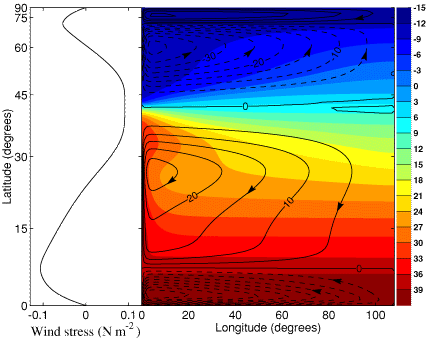
The large-scale oceanic currents that redistribute heat, salt and momentum in the top kilometer of water are driven by the mechanical stress exerted by the winds at the air-sea interface. In turn, the surface winds are shaped by the north-south temperature differences in the atmosphere. The temperature gradients in the atmosphere, largely determined by the sun's differential heating, are mitigated by the poleward heat transport due to the oceanic currents and the atmospheric flows. Thus, the ocean and the atmosphere work together to make our planet livable.
 |
| Figure 1. Left: Temporally and longitudinally averaged wind-stress. Right: Contours of oceanic mass transport (in black) and contours of sea surface temperatures (in colours) are on the right. The transport of sea surface temperatures by the oceanic currents creates a thermal front beneath the westerlies' maximum. |
Understanding the partitioning of heat transport between atmospheric and oceanic components, and how fluctuations arise because of the mutual interaction of the two systems, is a crucial aspect of climate dynamics. One approach is to construct simple models based on fundamental conservation principles of heat, salt and momentum.
Heat and salt are redistributed through a slow overturning circulation (the "conveyor belt"), which occupies the bottom three kilometers of the ocean and involves vertical velocities of the order of 3 meters per year. In the equatorial belt, high temperatures tend to create light surface water. However, because evaporation exceeds rainfall, salt is concentrated making the ocean water heavier. On the other hand, in high latitudes, the colder temperatures tend to create heavier water, yet melted ice and rain freshen the water trying to make it lighter. Thus there is an interesting temperature-salinity battle whose outcome has changed over the course of the earth's history. Depending on the dominance of either salt or temperature, the oceans' water will either sink at the pole and rise at the equator, or vice versa. In the present climate the two effects almost counterbalance each other, but temperature has the upper hand.